new posts in all blogs
Viewing: Blog Posts Tagged with: Guest Blogger Post, Most Recent at Top [Help]
Results 26 - 35 of 35
How to use this Page
You are viewing the most recent posts tagged with the words: Guest Blogger Post in the JacketFlap blog reader. What is a tag? Think of a tag as a keyword or category label. Tags can both help you find posts on JacketFlap.com as well as provide an easy way for you to "remember" and classify posts for later recall. Try adding a tag yourself by clicking "Add a tag" below a post's header. Scroll down through the list of Recent Posts in the left column and click on a post title that sounds interesting. You can view all posts from a specific blog by clicking the Blog name in the right column, or you can click a 'More Posts from this Blog' link in any individual post.

By:
hannahehrlich,
on 1/29/2015
Blog:
The Open Book
(
Login to Add to MyJacketFlap)
JacketFlap tags:
gender neutral,
Guest Blogger Post,
Diversity 102,
Gender/LGBTQ Diversity,
Call Me Tree,
LGBTQ Diversity,
New Releases,
maya christina gonzalez,
Educator Resources,
Add a tag
 Maya Christina Gonzalez is an award
Maya Christina Gonzalez is an award -winning author and illustrator. In this post, cross-posted from her website, Maya shares why she decided to make her new picture book, Call Me Tree/ Llámame árbol, completely gender neutral.
-winning author and illustrator. In this post, cross-posted from her website, Maya shares why she decided to make her new picture book, Call Me Tree/ Llámame árbol, completely gender neutral.
You may or may not notice something different about my new book, Call Me Tree. Nowhere in the story are boy/girl pronouns used. No ‘he’ or ‘she’ anywhere! I found it easy to write this way because that’s how I think of kids, as kids, not boy kids or girl kids.
I even requested that no ‘he’ or ‘she’ be used anywhere else in the book, like on the end pages or the back cover when talking about the story. I also asked the publisher to only refer to the main character as a child or kid when they talked about my book out in the world. Because I wanted Call Me Tree to be gender free!
Why? I’m glad you asked. Two reasons come to the top of my mind:
First, I know a lot of people. Some don’t feel that they fit into the boy or the girl box and of course, some do! By not using ‘he’ or ‘she,’ I could include everyone! This is very important to me. I want everyone to know that we all belong!
And second, I thought it would be a great opportunity to talk about the main character in Call Me Tree. Let’s call them ‘Tree.’ Tree is like a lot of people I know, including my own kids! Strong, curious, free! Now, if you were going to guess if Tree is a ‘he’ or a ‘she,’ which do you think?
I’m going to guess you’d say ‘he’ first, maybe because Tree’s already been called ‘he’ by folks who have given Call Me Tree some really awesome reviews. Tree could be he, but maybe not! A lot of times we make guesses based on what we think is true, but sometimes that can leave people out.
Tree’s reminding us there are lots of different ways to be!
I just remembered another top reason.
People who don’t fit into the boy or the girl box get teased more than anybody. This is extra not cool to me. I happen to know all kids rock, so I want to make sure the ones that get picked on the most know they rock! Right?!
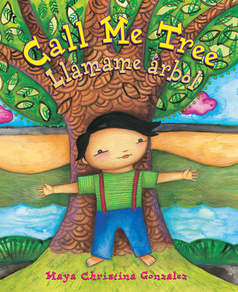
So Call Me Tree is gender free! Because all trees belong!
Try it on for a day. Play with not being called ‘he’ or ‘she,’ but only Tree, tall and strong! Just for one day, or even one afternoon. Would anything feel different? Would you be different?
Let’s call it Tree Day.
Let’s all be free. Let’s all be trees!
Whatdya think?
Call me Tree!
Love, mayatree
When sharing this book, you may want to include that it’s gender free as part of the conversation in your classroom, library or home if:
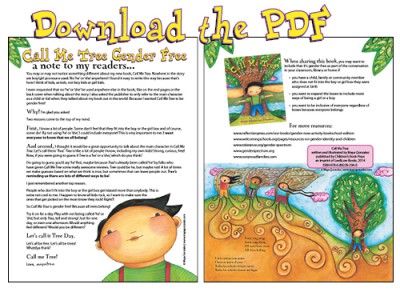
- you have a child, family or community member who does not fit into the boy or girl box they were assigned at birth
- you want to expand the boxes to include more ways of being a girl or a boy
- you want to be inclusive of everyone regardless of boxes because everyone belongs
Purchase a copy of Call Me Tree/ Llámame árbol
For more resources:
www.reflectionpress.com/our-books/gender-now-activity-bookschool-edition
www.welcomingschools.org/pages/resources-on-gender-identity-and-children
www.tolerance.org/gender-spectrum
www.genderspectrum.org
www.outproudfamilies.com

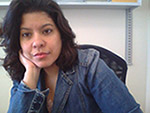 Marilisa Jimenez-Garcia, research associate at the Center for Puerto Rican Studies, Hunter College, CUNY, graduated from the University of Florida with a PhD in English, specializing in American literature/studies, nationalism, and children’s and young adult literature. Marilisa is also a National Council for Teachers of English (NCTE) Cultivating New Voices Among Scholar of Color Fellow. She is currently working on a manuscript on U.S. Empire, Puerto Rico, and American children’s culture. She is the recipient of the Puerto Rican Studies Association Dissertation Award 2012 and the University of Florida’s Dolores Auzenne Dissertation Award. Her scholarly work appears in publications such as Changing English: Studies in Culture and Education and CENTRO Journal. She has also published reviews in International Research in Children’s Literature and Latino Studies.
Marilisa Jimenez-Garcia, research associate at the Center for Puerto Rican Studies, Hunter College, CUNY, graduated from the University of Florida with a PhD in English, specializing in American literature/studies, nationalism, and children’s and young adult literature. Marilisa is also a National Council for Teachers of English (NCTE) Cultivating New Voices Among Scholar of Color Fellow. She is currently working on a manuscript on U.S. Empire, Puerto Rico, and American children’s culture. She is the recipient of the Puerto Rican Studies Association Dissertation Award 2012 and the University of Florida’s Dolores Auzenne Dissertation Award. Her scholarly work appears in publications such as Changing English: Studies in Culture and Education and CENTRO Journal. She has also published reviews in International Research in Children’s Literature and Latino Studies.
How might the legacy of the first Latina librarian at the New York Public Library speak to recent ‘human events’? 2014 was a landmark year with regard to discussions of race, diversity, and young people of color in American society. A game-changing year in which much of the rhetoric of multiculturalism we often use when preparing our young citizens unraveled. Indeed, by summer 2014, events had sparked a campaign by educators looking for new approaches and resources on how to discuss race in the classroom (Marcia Chatelain, “Ferguson Syllabus”). Those of us focused on the narrative and social literacy of young people seem at a place of no return—a place where we must admit that equality is not so in the Promised Land.(1)
As an American literature and childhood studies researcher, I was not surprised that 2014’s list of recurring headlines, including court rulings, protests, and policing, also contained debates about children’s books. What young people read, and the worlds, norms, histories, and people therein, have always mattered in the U.S. Children’s reading materials (e.g. fiction, history, and textbooks) have always been at the forefront of the “culture wars,” particularly after the Cold War. Ethical pleas for kid lit diversity are also nothing new. The start of Pura Belpré’s NYPL career in the 1920s is actually marked by a question similar to Walter Dean Myer’s op-ed in New York Times: “Where are the people of color in children’s books?” In Belpré’s case, she wanted to represent what she saw as the history and heritage of the Puerto Rican child. She began writing her own books as result of finding Puerto Rican culture absent from the shelves. However, considering the contributions by people of color to children’s literature over the last 90 years or so including Belpré, and numerous studies on the lack of representation, we find that calls for kid lit diversity consistently fail. (For further information see Nancy Larrick’s study “The All White World of Children’s Literature” The Saturday Review, September 11, 1965 and also work by the Council for Interracial Children’s Books). Post-2014, what is remarkable about our current moment is the amount of mainstream and field-wide attention the diversity issue has garnered. It also remains to be seen how the incorporation of We Need Diverse Books will impact the literary world.
 Here, I want to offer some reflections on Belpré’s career and legacy which might enable us to have a more critical, productive conversation on diversity:
Here, I want to offer some reflections on Belpré’s career and legacy which might enable us to have a more critical, productive conversation on diversity:
Conversation instead of compartmentalization. People of color including librarians and storytellers such as Pura Belpré and Augusta Baker were active (1920s and 1930s) when American children’s literature was advancing as a field with its own set of publishers, librarians, and prizes. The African American and Puerto Rican community have a longstanding tradition of employing children’s literature as a vehicle for imagination, cultural pride, and social consciousness.(2) Yet, systemically, people of color are left out of the conversation when it comes to accessing the breadth of children’s literature as an American tradition. Diversity should be understood as a conversation, rather than as a system of containing U.S. populations as compartments (with respective histories, literature, and cultural iconography) that never converge. A compartmentalized view hinders our ability to envision people of color as participants in the imagined landscapes of American history and culture—past, present, and future. Even our prizing system, including the Belpré Medal, tends to follow this logic of best Latino children’s literature, best African American children’s literature, but when it comes to best American children’s literature, people of color have historically fared in the single digits. Prizes such as the Belpré foster cultural pride, solidarity, and a market for Latino authors, yet they also continue the logic of compartmentalization.
Relevant instead of relatable. Belpré’s stories were based on folklore which some Latino/a children might find familiar. But, Belpré’s books are also artistic fiction. In other words, they are just stories to be enjoyed by whoever might enjoy them. As a teacher, I had to check my use of the term “relatable” when discussing literature with young people. Once we were reading The Outsiders (1967) and Nicholasa Mohr’s Nilda (1973) as means of comparing how young people grow up and encounter violence. I always remember one student closing her copy of Nilda, saying, “This is about culture, not about teens. I couldn’t really relate.” I was puzzled seeing that key characters in both books were adolescents. Certainly, when a Latino/a author writes about Latino/a characters, the story is shaped by Latino/a culture—which also varies in terms of racial, regional, gender, and national identity. But, the same is true for any author. Oliver Twist is a mainstream story, but it is also a commentary on 19th century childhood—a celebrated time for some who could afford it—and the conditions for poor, orphaned youth. Stories are always about culture. Yet, what we catalogue as “foreign” or “other” tells us more about ourselves than about the stories we read.
Imperfect characters instead of superheroes. When it comes to young readers, we have a tendency to want to simplify things that we adults even have a hard time understanding. Clearly, cognition is an issue. But our desire to create clear-cut heroes and villains in American history, or any history for that matter, will fail at best. Parents and teachers often battle for the representation of marginalized groups in textbooks. But, they rarely argue over whether or not America is an exceptional nation (Zimmerman).(3) Our approach to teaching and systemizing a heritage of American children’s literature should emphasize that this is a great nation shaped by imperfect people, whether dominant or marginalized. It’s complicated. Those we might see as heroes don’t always win or dominate “the bad guys.” In Belpré’s folklore, she often underlined this sense of imperfection. For example, she showed that even though the Tainos had beautiful values and bravery, they didn’t win every battle against the Spaniards (Once in Puerto Rico, 1977). Even the Medal named in her honor symbolizes this sense of complicated, converging histories in its use of the term “Latino/a.” This one term—which some even within our communities cannot agree upon—stands for those who represent multiple nations, histories, languages, and races. It’s not a perfect term. Nor, as my father always tells me, is this a perfect world. Sooner or later, our young people are going to learn that apart from any storybook or textbook. The pressure to present a perfect America often means that we erase the voices of the marginalized.
Here are some practical ways these principles might play out in the classroom:
- Consider talking with students about diversity and how they “see themselves” in books: Even with the best intentions, we have a tendency to talk about young people without asking their opinions. Try to have the start with them. If they are a bit older, have them read Walter Dean Myers op-ed for class discussion. You might ask them to journal about issues such as cultural authenticity in a book read for the class. Or you might ask them to write a story, graphic novel, science fiction adventure, or picture book about their communities as an assignment.
- Consider classroom presentation of books: We need to stop relegating people of color to special months in which we celebrate and include their stories. Although focusing on a particular group has its benefits, this should not override the other 11-months when they are excluded or barely mentioned. This also includes displays of books in your class library. Do you organize books alphabetically by author or by nationality and country?
- Consider genre: Avoid relying only on folklore, historical fiction, and biographies. This is also something publishers need to consider. Latino/as in particular have one of the lowest percentages in fantasy, science, and science fiction. Look for books in which people of color play active roles in actual and imagined societies.
For further reading:
Pura Belpré Lights the Storyteller’s Candle: Reframing the Legacy of a Legend and What it Means for the Fields of Latino/a Studies and Children’s Literature by Marilisa Jiménez-García in CENTRO Journal.
- R.L. L’Heureux, Inequality in the Promised Land (Stanford University Press, 2014)
- Katherine Capshaw-Smith, Children’s Literature of the Harlem Renaissance (Indiana University Press, 2006) and Marilisa Jimenez-Garcia, “Pura Belpré Lights the Storyteller’s Candle” (CENTRO Journal, Vol. 26, No. 1)
- Jonathan Zimmerman, Whose America?: Culture Wars in the Public Schools (Harvard University Press, 2002)

By:
jilleisenberg14,
on 12/8/2014
Blog:
The Open Book
(
Login to Add to MyJacketFlap)
JacketFlap tags:
reading comprehension,
close reading,
Educator Resources,
Common Core State Standards,
CCSS,
ELA common core standards,
ELL/ESL and Bilingual Books,
Guest Blogger Post,
children's books,
diversity,
Reading Aloud,
Race,
multicultural books,
Educators,
Add a tag

 Emily Chiariello is a Teaching and Learning Specialist with Teaching Tolerance. She has 15 years’ experience as a classroom teacher, professional development and curriculum designer in public, charter and alternative school settings, as well as with non-profit organizations. She holds a master’s degree in philosophy and social policy and is certified in secondary social studies.
Emily Chiariello is a Teaching and Learning Specialist with Teaching Tolerance. She has 15 years’ experience as a classroom teacher, professional development and curriculum designer in public, charter and alternative school settings, as well as with non-profit organizations. She holds a master’s degree in philosophy and social policy and is certified in secondary social studies.
Here she discusses Teaching Tolerance’s new curriculum tool, “Project Appendix D,” that empowers educators to identify texts that both meet the demands of the Common Core Standards and reflect the world in which our students live. This blog post was originally posted at the Teaching Tolerance blog.
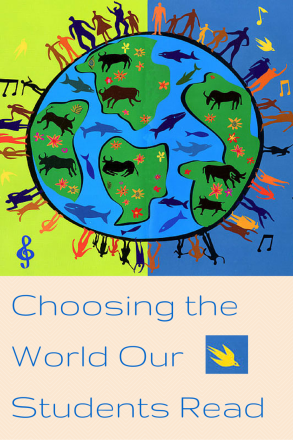
by Emily Chiariello
Does the Common Core limit what texts teachers can use? While many people think so, we don’t. Teaching Tolerance believes it is possible—and important—to choose texts that are both rigorous and relevant. Read on to learn about a new approach to text selection: Appendix D: A Tool for Selecting Diverse Texts. This exciting project goes beyond the resources offered in Appendices A and B and offers a new world of possibilities within literacy instruction.
Appendices A and B
Teachers are expected—per the CCSS’s Appendix A—to select more complex texts, teach more nonfiction and ask more text-dependent questions. But do they feel less empowered to choose readings about social justice or to locate texts that reflect the identities and histories of their students and communities? We’re concerned the answer is yes. We know that teachers want texts that mirror their students’ lives. And to achieve equitable outcomes, the Common Core must be implemented in culturally responsive ways that address social emotional learning as well as academic goals. Yet, this kind of implementation is not happening in most districts.
At first glance, one might think that the “Reader and Task” portion of the text selection model in Appendix A makes room for culturally responsive instructional decisions. Instead, there’s only a brief and bland mention of “reader variables”—motivation, knowledge and experiences—ultimately eclipsed by the other two measures: hard Lexile scores (quantitative) and subjective interpretations of meaning and purpose (qualitative).
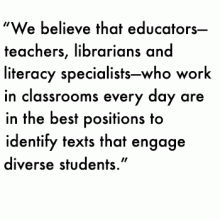 And then there’s the stark imprint of privilege found in the gaps and silences of Appendix B, a list of “text exemplars” that meet the aforementioned approach to text complexity, quality and range. Too many publishers—and districts, too—have interpreted the text exemplars listed in Appendix B as a required reading list.
And then there’s the stark imprint of privilege found in the gaps and silences of Appendix B, a list of “text exemplars” that meet the aforementioned approach to text complexity, quality and range. Too many publishers—and districts, too—have interpreted the text exemplars listed in Appendix B as a required reading list.
Woefully few examples of cultural relevance can be found in “Common Core-aligned” materials and trainings, including Appendix B. Jane M. Gangi, professor of education at Mount Saint Mary College, has analyzed Appendix B and found that, of the 171 texts recommended for children in K-5, only 18 are by authors of color, and few reflect the lives of children of color and children in poverty.
Appendix D
We believe that educators—teachers, librarians and literacy specialists—who work in classrooms every day are in the best positions to identify texts that engage diverse students.
That’s why we’re excited to share our new project: Appendix D: A Tool for Selecting Diverse Texts. Traditionally, tools that support text selection have focused on quantitative and qualitative measures only. But Appendix D promotes a multi-dimensional approach to text selection that prioritizes complexity as well as critical literacy and cultural responsiveness.
Appendix D empowers educators to rely on their knowledge of their students, rather than a prepopulated lists of titles, when selecting texts. The tool walks users through four distinct—but interconnected—text-selection considerations: complexity, diversity and representation, critical literacy, and reader and task. And it’s an editable PDF, allowing folks to document, save and share their text-selection process. (Be sure to download to unlock the editing capabilities.)
So, why a tool and not a list? There are commendable lists out there. Gangi and the Collaborative for Equity Literacy Learning (CELL) assembled an alternative list of multicultural titles, but they are not leveled for teachers to assess text complexity. Others, like publishers LEE & LOW, work to bring more diversity and representation into classroom libraries, and to the task of text selection. However, none of the lists we’ve investigated encompass texts that are both culturally relevant and meet the Common Core’s requirements for complexity. And, unless it is dynamic, any list of diverse books is only as diverse as the person—or people—who made it.
We hope the TT community will use Appendix D to help us grow a dynamic and diverse list of texts based on the four considerations and on the diverse needs of our students. We’ve started with the titles currently found in Perspectives for a Diverse America, our new anti-bias curriculum. In the months to come, as you use the Appendix D tool in your own practice, think of which complex, culturally relevant titles you think your fellow social justice educators would want to know about—and be on the lookout for an invitation to submit your texts to the ever-growing, ever-changing TT community list!
Paulo Freire wrote that, when we read words, we read the world. Don’t we owe it to our students to consider them when choosing those words?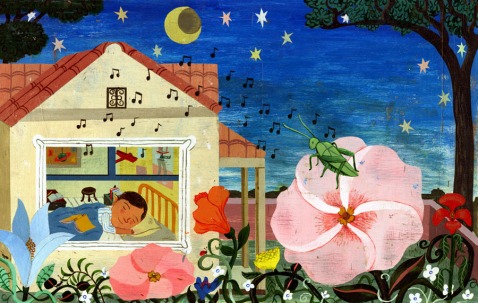
Filed under:
Common Core State Standards,
Educator Resources,
ELL/ESL and Bilingual Books,
Guest Blogger Post,
Race Tagged:
CCSS,
children's books,
close reading,
diversity,
Educators,
ELA common core standards,
multicultural books,
Reading Aloud,
reading comprehension 

 Illustrator Frané Lessac shares a recent school visit that she and her husband, author Mark Greenwood, did in Washington, D.C. with An Open Book Children’s Literacy Foundation.
Illustrator Frané Lessac shares a recent school visit that she and her husband, author Mark Greenwood, did in Washington, D.C. with An Open Book Children’s Literacy Foundation.
One of the highlights of our recent US tour was our visit to Washington, D.C. and our Open Book Foundation day, working with three second grade classes at Savoy Elementary.
The foundation’s mission is to promote literacy among disadvantaged children and teens in the greater Washington, D.C. area by giving books to students and providing access to authors and illustrators – and what a unanimously positive experience it is for all involved!
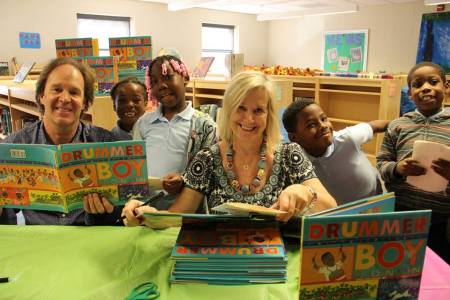
Frané and Mark at Savoy Elementary (image courtesy of An Open Book Foundation)
We conducted a ‘Meet the Author and Illustrator’ presentation followed by an art activity. At the conclusion of each presentation, the Open Book Foundation gave each student a copy of our book, Drummer Boy of John John, to take home, signed and personalized by the people who actually wrote and illustrated it.
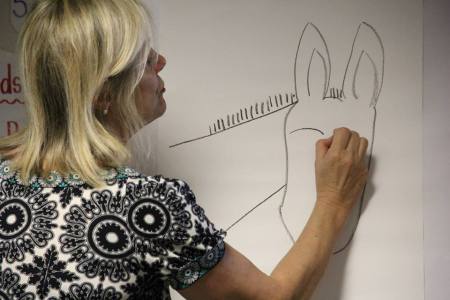
Frané Lessac demonstrating the illustration process (image courtesy of An Open Book Foundation)
Here are a few of the student reactions we received:
“You mean we get to keep the book? We don’t have to bring it back?”
“I can keep this book for my entire life. Even when I grow up?”
Wow! While the students might still be talking about the experience, so are we! The Open Book program is as uplifting and rewarding for authors and illustrators as it is for students. We will never forget the look of joy on the faces of the students, who couldn’t wait to take their new books home and share the experience with their families.
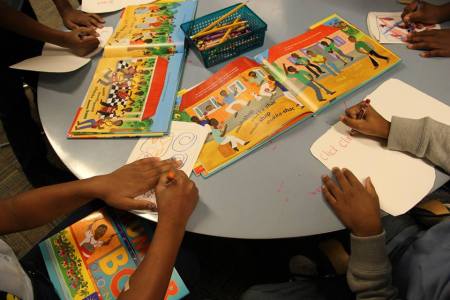
Creating art during the visit (image courtesy of An Open Book Foundation)
The fabulous Open Book experience breathes life into writing and art and the process of bookmaking, and opens up the world of reading to students. The Savoy Elementary students were so excited to leave each of our sessions clutching their very own book.
We cannot express our gratitude enough to the Open Book Foundation for the joy and excitement they bring to disadvantaged children. The Foundation’s program of bringing authors and illustrators to their schools, and providing books for their students, classrooms and libraries, is a wonderfully positive step to introduce a lifelong love of books and reading.
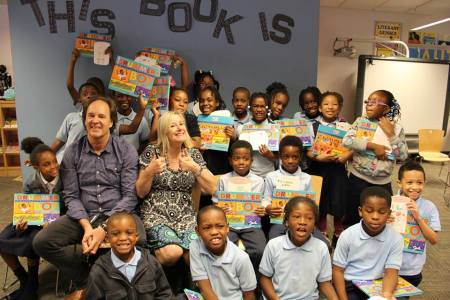
Frané and Mark with some happy readers (image courtesy of An Open Book Foundation)
To learn more about An Open Book Children’s Literacy Foundation, visit their website.

 Frané Lessac has illustrated more than thirty-five books for young readers, several of which she has also written. Her husband, Mark Greenwood, is the author of numerous children’s books published in both the United States and his native Australia. They live in Fremantle, West Australia.
Frané Lessac has illustrated more than thirty-five books for young readers, several of which she has also written. Her husband, Mark Greenwood, is the author of numerous children’s books published in both the United States and his native Australia. They live in Fremantle, West Australia.
Filed under:
Activities and Events,
Educator Resources,
Guest Blogger Post Tagged:
An Open Book Foundation,
literacy,
nonprofits,
Washington D.C. 


By: Kathy Temean,
on 10/21/2014
Blog:
Writing and Illustrating
(
Login to Add to MyJacketFlap)
JacketFlap tags:
Writing Tips,
inspiration,
Advice,
article,
How to,
Guest Blogger Post,
A Dialogue Tune Up,
Erika Walssal,
Mastering Kid-Speak,
Add a tag
 Jersey Farm Scribe here on…
Jersey Farm Scribe here on…
A Dialogue Tune-up: Mastering Kid-Speak
Dialogue is one of the most important pieces of any manuscript, and this often goes double for children’s works. Dialogue moves the story along, develops the connection between your readers and the characters and keeps things tangible and realistic.
That means that mastering Kid-Speak is unequivocally important.
There is a rhyme and rhythm to the way that kids communicate, where they pause to think, how they choose their words, the direction their stream of conscious takes them in. I’ve often wondered if there are linguists who study children specifically. I bet we could learn a lot about the development of the brain and human instincts by looking at how and why kids pick their words.
As writers, if our characters don’t sound realistic, we’ve already lost the battle. It’s something a child will instantly and instinctively pick up on. The character will seem fake and they won’t bond with them. Even in a plot-driven story, if the readers don’t connect with the characters, the story won’t resonate.
Here are a few things you can do to work on the dialogue in your stories:
Eavesdrop!
Listening to children talk is one of my favorite things to do. This can be a bit trickier to do with older kids. Teenagers aren’t big on you overhearing their devastatingly important and secret information. But there’s a great trick to overcome that. Stick two or more kids in the back of a car and drive around a while. Even teenagers will fairly quickly forget that you can probably hear them and get swept up in the excitement of their chatter. When hushed whispers are completely ignored, they often become full-volume conversations within a few minutes.
It’ll be a hit with the other adults in your life too! The fact that I’m quick to volunteer for anything kid and car-pool related is a much-appreciated running joke among my friends and family.
Listen to yourself:
Most writers understand the value of reading the dialogue sections of a manuscript out-loud. But you can take this even further. Record yourself reading it. Play it back. Have someone else read it to you. Have multiple someones read it to you.
Better yet, have an age-appropriate child read it to you. See how it sounds coming from them. Does it sound natural? Stale? Funny? Bland? Vocabulary that encourages learning and reaching is excellent when carefully placed in children’s books. But (unless it’s your character’s quirk) you want to keep the dialogue age-appropriate.
Hearing how the lines sound with the natural intonation of a child’s voice can be a simple and surprisingly effective way of polishing up the dialogue.
Give Everyone Their Own Unique Voice
If you ask five kids the same question, you will get five different responses, even if they all have the same general answer. You have a voice as a writer. Be sure each of your characters has a voice of their own as well.
We all have our little verbal tics, especially kids. Some are simple speakers, short, two to three word sentences. Some seem to look for any opportunity to use flowery, descriptive words. They know different words based on who and what occupies the majority of their time.
A friend’s five year old used the word “bonemeal” when he was commenting on my conversation with his mother about my garden next year. Turns out, it’s basically a type of fertilizer in Minecraft. I was amazed that he made the connection to a real-life garden, but it was just his natural Kid-Speak.
A great test for this is to pull out all the dialogue in your manuscript and see if you can tell who said what without even looking at the character name.
It’s not an easy test. But for me, it’s given me great perspective on places I need to have the opportunity to personalize and develop that critical bond between my readers, and the characters they’re going to take the journey with.
Dialogue does so much in our manuscripts. It allows us to remove unnecessary words, breaks up long, difficult to read paragraphs, advances the story, gives us relatable realism and lets us see how a character thinks. Take these opportunities to really let the uniqueness of your characters shine, and capture your readers.
Kid-Speak varies for different ages, backgrounds and situations, making it a versatile and powerful tool to make your story, and your character jump off the page and into the reader’s heart.
Your character’s personalities, and your manuscripts, are worth it.
Erika Wassall is a writer, a farmer and a liver of life. She is a member of SCBWI and a proud Mad Scientist, bringing science experiments right into children’s classrooms, and hearts. She has a small farm in New Jersey with sheep, chickens, pigs and vegetables. Check out her new website at www.TheJerseyFarmScribe.com where as a first generation farmer, she often takes the long way, learning the tricks of the trade on The Farm. On her website is also The Shop page with tips and a free Q/A from her husband’s mechanic shop, and The Writer page where she shares stories, experiences and characters from the heart. Follow her on Twitter at @NJFarmScribe. She’d love to hear from you!
Thank you Erika for another great post. I always enjoy them.
Talk tomorrow,
Kathy
Filed under:
Advice,
article,
How to,
inspiration,
Writing Tips Tagged:
A Dialogue Tune Up,
Erika Walssal,
Guest Blogger Post,
Mastering Kid-Speak 


By:
keilinh,
on 10/21/2014
Blog:
The Open Book
(
Login to Add to MyJacketFlap)
JacketFlap tags:
Economics,
money,
Paula Yoo,
banking,
banks,
loans,
Musings & Ponderings,
nobel peace prize,
Muhammad Yunus,
bangladesh,
Lee & Low Likes,
Guest Blogger Post,
grameen bank,
loan shark,
microcredit,
poverty,
Add a tag
 Paula Yoo is a children’s book writer, television writer, and freelance violinist living in
Paula Yoo is a children’s book writer, television writer, and freelance violinist living in Los Angeles. Her latest book, Twenty-two Cents: Muhammad Yunus and the Village Bank, was released last month. Twenty-two Cents is about Muhammad Yunus, Nobel Peace Prize winner and founder of Grameen Bank. He founded Grameen Bank so people could borrow small amounts of money to start a job, and then pay back the bank without exorbitant interest charges. Over the next few years, Muhammad’s compassion and determination changed the lives of millions of people by loaning the equivalent of more than ten billion US dollars in micro-credit. This has also served to advocate and empower the poor, especially women, who often have limited options. In this post, we asked her to share advice on what’s she’s learned about banking, loans, and managing finances while writing Twenty-two Cents.
Los Angeles. Her latest book, Twenty-two Cents: Muhammad Yunus and the Village Bank, was released last month. Twenty-two Cents is about Muhammad Yunus, Nobel Peace Prize winner and founder of Grameen Bank. He founded Grameen Bank so people could borrow small amounts of money to start a job, and then pay back the bank without exorbitant interest charges. Over the next few years, Muhammad’s compassion and determination changed the lives of millions of people by loaning the equivalent of more than ten billion US dollars in micro-credit. This has also served to advocate and empower the poor, especially women, who often have limited options. In this post, we asked her to share advice on what’s she’s learned about banking, loans, and managing finances while writing Twenty-two Cents.
What are some reasons why someone might want to take out a loan? Why wouldn’t banks loan money to poor people in Bangladesh?
PAULA: People will take out a loan when they do not have enough money in their bank account to pay for a major purchase, like a car or a house. Sometimes, they will take out a loan because they need the money to help set up a business they are starting. Other times, loans are also used to help pay for major expenses, like unexpected hospital bills for a family member who is sick or big repairs on a house or car. But asking for a loan is a very complicated process because a person has to prove they can pay the loan back in a reasonable amount of time. A person’s financial history can affect whether or not they are approved for a loan. For many people who live below the poverty line, they are at a disadvantage because their financial history is very spotty. Banks may not trust them to pay the loan back on time.
In addition, most loans are given to people who are requesting a lot of money for a very expensive purchase like a house or a car. But sometimes a person only needs a small amount of money – for example, a few hundred dollars. This type of loan does not really exist because most people can afford to pay a few hundred dollars. But if you live below the poverty line, a hundred dollars can seem like a million dollars. Professor Yunus realized this when he met Sufiya Begum, a poor woman who only needed 22 cents to keep her business of making stools and mats profitable in her rural village. No bank would loan a few hundred dollars, or even 22 cents, to a woman living in a mud hut. This is what inspired Professor Yunus to come up with the concept of “microcredit” (also known as microfinancing and micro banking).
In TWENTY-TWO CENTS, microcredit is described as a loan with a low interest rate. What is a low interest rate compared to a high interest rate?
PAULA: When you borrow money from a bank, you have to pay the loan back with an interest rate. The interest rate is an additional amount of money that you now owe the bank on top of the original amount of money you borrowed. There are many complex math formulas involved with calculating what a fair and appropriate interest rate could be for a loan. The interest rate is also affected by outside factors such as inflation and unemployment. Although it would seem that a lower interest rate would be preferable to the borrower, it can be risky to the general economy. A low interest rate can create a potential “economic bubble” which could burst in the future and cause an economic “depression.” Interest rates are adjusted to make sure these problems do not happen. Which means that sometimes there are times when the interest rates are higher for borrowers than other times.

What is a loan shark?
PAULA: A loan shark is someone who offers loans to poor people at extremely high interest rates. This is also known as “predatory lending.” It can be illegal in several cases, especially when the loan shark uses blackmail or threats of violence to make sure a person pays back the loan by a certain deadline. Often people in desperate financial situations will go to a loan shark to help them out of a financial problem, only to realize later that the loan shark has made the problem worse, not better.
Did your parents explain how a bank works to you when you were a child? Or did you learn about it in school?
PAULA: I remember learning about how a bank works from elementary school and through those “Schoolhouse Rocks!” educational cartoons they would show on Saturday mornings. But overall, I would say I learned about banking as a high school student when I got my first minimum wage job at age 16 as a cashier at the Marshall’s department store. I learned how banking worked through a job and real life experience.
TWENTY-TWO CENTS is a story about economic innovation. Could you explain why Muhammad Yunus’s Grameen Bank was so innovative or revolutionary?
PAULA ANSWER: Muhammad Yunus’ theories on microcredit and microfinancing are revolutionary and innovative because they provided a practical solution on how banks can offer loans to poor people who do not have any financial security. By having women work together as a group to understand how the math behind the loan would work (along with other important concepts) and borrowing the loan as a group, Yunus’ unique idea gave banks the confidence to put their trust into these groups of women. The banks were able to loan the money with the full confidence in knowing that these women would be able to pay them back in a timely manner. The humanitarian aspect of Yunus’ economic theories were also quite revolutionary because it gave these poverty-stricken women a newfound sense of self-confidence. His theories worked to help break the cycle of poverty for these women as they were able to save money and finally become self-sufficient. The Nobel Committee praised Yunus’ microcredit theories for being one of the first steps towards eradicating poverty, stating, “Lasting peace cannot be achieved unless large population groups find ways in which to break out of poverty.”
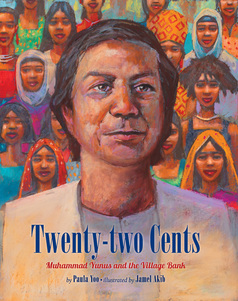 Twenty-two Cents: Muhammad Yunus and the Village Bank is a biography of 2006 Nobel Peace Prize winner Muhammad Yunus, who founded Grameen Bank and revolutionized global antipoverty efforts by developing the innovative economic concept of micro-lending.
Twenty-two Cents: Muhammad Yunus and the Village Bank is a biography of 2006 Nobel Peace Prize winner Muhammad Yunus, who founded Grameen Bank and revolutionized global antipoverty efforts by developing the innovative economic concept of micro-lending.
Filed under: Guest Blogger Post, Lee & Low Likes, Musings & Ponderings Tagged: bangladesh, banking, banks, Economics, grameen bank, loan shark, loans, microcredit, money, Muhammad Yunus, nobel peace prize, Paula Yoo, poverty 


By:
Hannah,
on 9/30/2014
Blog:
The Open Book
(
Login to Add to MyJacketFlap)
JacketFlap tags:
gender,
sweden,
gender roles,
gender stereotypes,
Educator Resources,
Diversity, Race, and Representation,
Guest Blogger Post,
Diversity 102,
picture books around the world,
Add a tag
 Back in June, Laura Reiko Simeon wrote about how race is handled in Swedish picture books. We’re thrilled to host Laura again as she sheds light on how Swedish picture books handle gender and gender-ambiguous characters.
Back in June, Laura Reiko Simeon wrote about how race is handled in Swedish picture books. We’re thrilled to host Laura again as she sheds light on how Swedish picture books handle gender and gender-ambiguous characters.
You sit down with your favorite 4-year-old to read a sweet, wordless picture book featuring a little duck swimming down the river. Quickly, without thinking too hard, what pronoun do you use to describe the duck? Do you say, “Look at him paddle past that shaggy dog!” or “What does she see in the sky?”
If you were like the mothers in a 1985 study, you would use masculine pronouns for 95% of animal characters with no gender-specific characteristics. A follow-up study from 1995 examined children’s use of pronouns and found that by age 7 they had absorbed and were repeating these same gender stereotypes. Listen to those around you: has it changed much since then?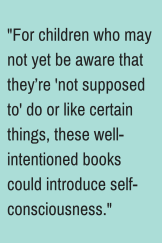
In the US, Sweden is widely regarded as a leader in gender equality, although many Swedes still see a need for greater progress. Meanwhile, our own biases are apparent, for example when we consider gendered toys. Compare this 1981 Lego ad, with its blue jeans and t-shirt-clad girl to the pink-infused products targeted at girls today. As with other social issues, picture books reflect concerns in society at large – but how they’ve done so is dramatically different in the US as compared to Sweden.
Some American picture books encourage acceptance of kids who break free from gender restrictions: Charlotte Zolotow’s William’s Doll, Cheryl Kilodavis’s My Princess Boy, and Campbell Geeslin’s Elena’s Serenade, among others. The point of these stories is that a character is acting in opposition to gender norms, but for children who may not yet be aware that they’re “not supposed to” do or like certain things, these well-intentioned books could introduce self-consciousness.
What have largely been missing from English-language picture books are deliberately gender-ambiguous characters that are neither being bullied nor defiant. They just are. Rather than focusing on the consequences (good or bad) of pushing against societal restrictions or elevating the rebel as cultural hero, they turn the focus on the reader. Do we feel uncomfortable if we don’t know someone’s gender? Why? Do we make assumptions about gender based on what someone is doing or wearing? Why?
We do have some characters – e.g. the diverse, roly-poly infants in Helen Oxenbury’s delightful baby books – that are non-gender specific, but they tend to be in simple, relatively plot-free books for the very young. They are distinct from the Swedish picture books in which pronouns are cleverly avoided and characters send deliberately contradictory gender signals. My earlier post about
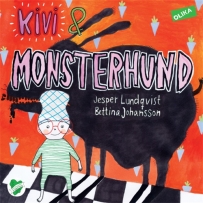
Kivi and the Monster Dog
Swedish approaches to ethnic diversity introduced the concept of not making difference the problem. There is a similar philosophy at work here.
The Swedish Institute for Children’s Books publishes annual “Book Tastings” that identify trends for the year’s publications. The theme for 2012 was “Borders and Border Crossings,” and one border was gender: not just sexual orientation or gender roles, but the concept of gender as an identifier itself.
The anti-bias publisher OLIKA has published several titles of this nature, but the one that made the biggest splash was Kivi and the Monster Dog by Jesper Lundqvist, the first children’s book to use the gender-neutral pronoun, “hen.” (In Swedish, “hon” means “she” and “han” means “he.” First proposed in the 1960s, “hen” was mostly used in academic research and hipster neighborhoods of Stockholm.) In this funny rhyming story, a small person, Kivi, wishes for a pet dog and ends up instead with a demanding beast that runs amok.
Åsa Mendel-Hartvig and Caroline Röstlund write about Tessla, a preschooler clad in gender-neutral clothes and boasting a mop of brown hair. In Tessla’s Mama Doesn’t Want To! and Tessla’s Papa Doesn’t Want To!, the child, in an amusing role reversal, creatively cajoles badly behaving parents into leaving the park, washing their hair, waking up on time or going to work.
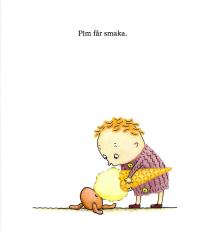
interior page from Pom and Pim
Pom and Pim by Olof and Lena Landström may be the only Swedish gender-neutral book that has been translated into English. The first in a series, it features an adventurous toddler, Pom, who sends mixed gender signals: a boyish-sounding nickname, sparse curls, a long purple sweater, and a little pink toy (Pim). The story is told without pronouns, yet two professional American reviewers assumed Pom was male and referred to the character as “he.”
In Maria Nilsson Thore’s Bus and Frö Each on Their Own Island, two gender-ambiguous animals reach out from their lonely islands to become friends. One is shown variously smoking a pipe and knitting. In Jonatan Brännström’s The Lightning Swallower, we never learn the gender of the narrator, who is terrified of thunderstorms.
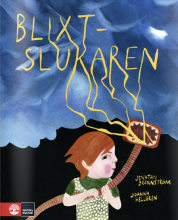
The Lightning Swallower
These books make a reader consider what markers are “masculine” or “feminine” – and why. They don’t dictate what you “should” do – rebel or conform – or offer value judgments about those who do either. In English-language books, feisty heroines reject traditionally female pursuits as “boring” (what about those girls who do love sewing and cooking?) and boys are persecuted for their love of pink and dolls (making these preferences seem risky to express). With their gender-ambiguous characters, Swedes have tilted the lens slightly and given us a whole new perspective through which to consider this topic. Can we change the terms of the discussion instead of framing everything in terms of binary gender categories? Where could that small but crucial shift take us?
 The daughter of an anthropologist, Laura Reiko Simeon’s passion for diversity-related topics stems from her childhood spent living all over the US and the world. She fell in love with Sweden thanks to the Swedish roommate she met in Wales while attending one of the United World Colleges, international high schools dedicated to promoting cross-cultural understanding. Laura has an MA in History from the University of British Columbia, and a Master of Library and Information Science from the University of Washington. She lives near Seattle.
The daughter of an anthropologist, Laura Reiko Simeon’s passion for diversity-related topics stems from her childhood spent living all over the US and the world. She fell in love with Sweden thanks to the Swedish roommate she met in Wales while attending one of the United World Colleges, international high schools dedicated to promoting cross-cultural understanding. Laura has an MA in History from the University of British Columbia, and a Master of Library and Information Science from the University of Washington. She lives near Seattle.
Filed under:
Diversity 102,
Diversity, Race, and Representation,
Educator Resources,
Guest Blogger Post Tagged:
gender,
gender roles,
gender stereotypes,
picture books around the world,
sweden 


By:
keilinh,
on 9/28/2014
Blog:
The Open Book
(
Login to Add to MyJacketFlap)
JacketFlap tags:
Educators,
Andrea Cheng,
Children's Book Press,
Lulu Delacre,
grandfather counts,
family activities,
Musings & Ponderings,
Educator Resources,
kid activities,
i love you book,
Lee & Low Likes,
Activities and Events,
Art and Book Design,
Guest Blogger Post,
activity basket,
educator activities,
educators' spin on it,
family basket,
How Far Do You Love Me,
arts and crafts,
honoring our ancestors,
Add a tag
 Amanda Boyarshinov is one of the creators of the blog, The Educators’ Spin On It, a site that makes everyday moments into teachable opportunities. She has a Master of Reading Education for grades K-12 and a B.A. in Elementary Education. Additionally, she has her English Speakers of Other Languages (E.S.O.L.) endorsement and has received her National Board Certification in Early Childhood Education. In this post, we’ve been given permission to share her steps on building a family theme Love Book Basket, as well as how to create an “I Love You” book.
Amanda Boyarshinov is one of the creators of the blog, The Educators’ Spin On It, a site that makes everyday moments into teachable opportunities. She has a Master of Reading Education for grades K-12 and a B.A. in Elementary Education. Additionally, she has her English Speakers of Other Languages (E.S.O.L.) endorsement and has received her National Board Certification in Early Childhood Education. In this post, we’ve been given permission to share her steps on building a family theme Love Book Basket, as well as how to create an “I Love You” book.
HOW TO BUILD A FAMILY THEME LOVE BOOK BASKET
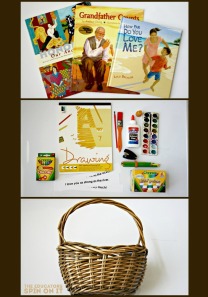
1. Choose a Book
Select themed literature that is appropriate for your child’s age. Younger children may enjoy shorter stories. Older children may like more detailed picture books. Consider both non-fiction and fiction text. Lee and Low Publishing Company sent me the 3 books to read with my children for this article. All thoughts and opinions are 100% my own.
How Far Do You Love Me?
How Far Do You Love Me? is a delightful tale of families all around the world and how much they love their children. Each page introduces a new place on the globe, with a sweet sentence about their love. Geared for 3-6 year olds Click here for the Teachers Guide
Grandfather Counts
Grandfather Counts (Reading Rainbow Books) is a picture book about making connections with your family, no matter what the language may be. Author Andrea Cheng draws upon her own family and friends experiences to weave this tale of love and family. Geared for 6-8 year olds It is a Reading Rainbow selection Click here for the Teachers Guide
Honoring Our Ancestors
Honoring Our Ancestors: Stories and Paintings by Fourteen Artists is a non-fiction picture book highlighting some AMAZING artists: Carl Angel, Enrique Chagoya, George Crespo, Mark Dukes, Maya Gonzalez, Caryl Henry, Nancy Hom, Hung Liu, Judith Lowery, Stephen Von Mason, Mira Reisberg, JoeSam, Patssi Valdez, and Helen Zughaib. Each short story and accompanying artwork gives the reader a snapshot into the importance of family to that artist. Geared for 8-10 year olds.
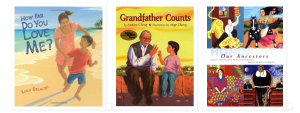
2. Gather the Supplies for the Selected Activity.
In this activity, children make an “I Love You,” book for a family member. This can be done with art materials around the house. Directions for each page below.
3. Arrange and Display.
Arrange the materials and books in a pleasing manor in a basket, bag or container. Then, leave it on a table or desk area as an invitation to explore. Snuggle in and read. Then make the activity!
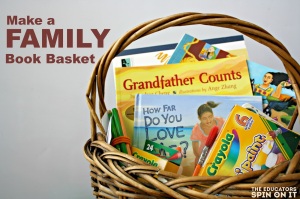 You can find directions (and pictures) on how to make an “I Love You” book on The Educators’ Spin On It website.
You can find directions (and pictures) on how to make an “I Love You” book on The Educators’ Spin On It website.
Make your #LOVEdiverseBooks Basket today!
Stay TUNED!!!!
Next week, The Educators’ Spin On It will be highlighting author Andrea Cheng, author of Grandfather Counts. Here is a sneak peek…
Filed under: Activities and Events, Art and Book Design, Educator Resources, Guest Blogger Post, Lee & Low Likes, Musings & Ponderings Tagged: activity basket, Andrea Cheng, arts and crafts, Children's Book Press, educator activities, Educators, educators' spin on it, family activities, family basket, grandfather counts, honoring our ancestors, How Far Do You Love Me, i love you book, kid activities, Lulu Delacre 


By:
Jason Low,
on 7/29/2014
Blog:
The Open Book
(
Login to Add to MyJacketFlap)
JacketFlap tags:
diversity,
LGBT,
Native American,
Science Fiction/Fantasy,
African/African American Interest,
whitewashing,
Race issues,
Multiracial,
Middle Eastern,
Asian/Asian American,
Latino/Hispanic/Mexican,
The Diversity Gap,
Diversity, Race, and Representation,
Guest Blogger Post,
Add a tag
Summer blockbuster season is in full swing. For many moviegoers, that means escaping to a galaxy far, far away—or perhaps just a different version of our own planet Earth—through science fiction and fantasy movies. As fans clamor for the latest cinematic thrills, we decided to focus our next Diversity Gap study on the level of racial and gender representation in these ever-popular genres that consistently rake in the big bucks for movie studios. We reviewed the top 100 domestic grossing sci-fi and fantasy films as reported by Box Office Mojo. The results were staggeringly disappointing, if not surprising in light of our past Diversity Gap studies of the Tony Awards, the Emmy Awards, the children’s book industry, The New York Times Top 10 Bestseller List, US politics, and the Academy Awards, where we analyzed multi-year samplings and found a disturbingly consistent lack of diversity.
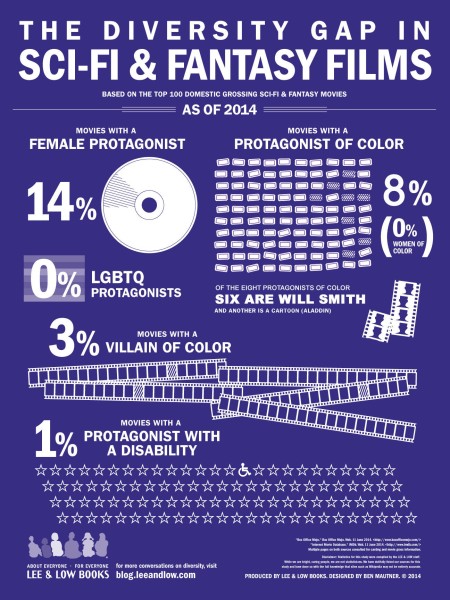
The Diversity Gap in Sci-Fi & Fantasy Films infographic (click for larger image)
Among the top 100 domestic grossing films through 2014:
• only 8% of films star a protagonist of color
• of the 8 protagonists of color, all are men; 6 are played by Will Smith and 1 is a cartoon character (Aladdin)
• 0% of protagonists are women of color
• 0% of protagonists are LGBTQ
• 1% of protagonists are people with a disability
The following interviews with two prominent entertainment equality advocacy groups shed more light on the subject.

Marissa Lee is co-founder of Racebending.com, an international grassroots organization of media consumers who support entertainment equality. Racebending.com advocates for underrepresented groups in entertainment media and is dedicated to furthering equal opportunities in Hollywood and beyond.

Imran Siddiquee is Director of Communications at the Representation Project, which is a movement that uses film and media content to expose injustices created by gender stereotypes and to shift people’s consciousness toward change. The Representation project was the follow-up to the critically acclaimed documentary Miss Representation.
Jason Low: Do these statistics surprise you? Why or why not?
Marissa Lee: The statistics are certainly striking, especially since sci-fi and fantasy belong to a genre that prides itself on creativity and imagination. These statistics aren’t necessarily surprising, since lack of diversity in Hollywood films is a well-known problem. There have been enough studies and articles, and any moviegoer can pause to notice there is a disparity. . . . Hollywood can’t go on pretending that this isn’t a problem.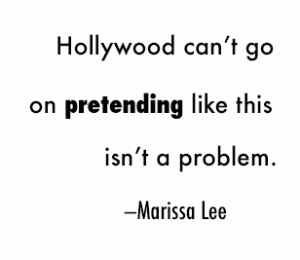
JL: Do you think the American movie-going audience would support a big, blockbuster sci-fi/fantasy movie with a diverse protagonist if a studio made it?
Imran Siddiquee: Yes, definitely. But I think an important thing to understand about Hollywood blockbusters is that they are almost never flukes; they are preordained. Sure, we have the occasional surprise indie hit, but you need a lot of money and marketing behind you to become a blockbuster. Just look at the top ten films in each of the last five years: nearly every single one had a budget of more than $100 million (a lot of them were also sci-fi/fantasy films).
Meanwhile, there hasn’t been a single film released this year starring a person of color with a budget of more than $50 million, let alone a sci-fi film, which is naturally going to be more expensive. The same goes for most of the last decade. So for anyone who might say “people just don’t watch sci-fi movies starring people of color,” or “there’s no evidence that this would work,” the truth is that we have no evidence that it wouldn’t work.
Studios take a couple of massively expensive chances every year on mostly unknown actors or directors—aka giving the Spider-Man franchise to Marc Webb and Andrew Garfield in 2012—but they just don’t take those kinds of chances on people of color. In other words, if Hollywood wanted to make a blockbuster sci-fi/fantasy film starring a woman of color, they definitely could.
ML: I think American audiences would support a film with a diverse protagonist, because we already have. One pullout statistic from your infographic is that Will Smith leads six of the top 100 big sci-fi/fantasy films. His race wasn’t a huge impediment to box office success and may have, in fact, been part of what made him all-American and relatable. That was back in the late 1990s, but since then, Hollywood hasn’t tried to find a new Will Smith. This is kind of ironic, given that Hollywood likes to stick to formulas and sequels! They could push forward another actor—or actress—of color with Smith’s charisma. They haven’t.
The American movie audience supports any movie that Hollywood successfully markets well, especially—but not always—if the film is well produced. Hollywood has managed to market some weird stuff, like a tentpole movie about talking teenage turtle martial artists, or cars that change into space robots, and so on. I don’t buy that when it comes to marketing diverse leads, suddenly this giant industry can’t do it.
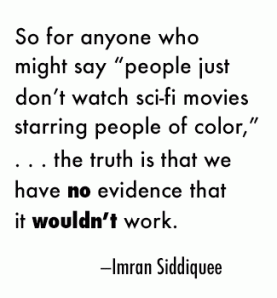 I’d be interested in seeing how many of these top 100 grossing sci-fi and fantasy films star non-human leads. I wonder if there are more films with non-human leads than minority human leads on the list!
I’d be interested in seeing how many of these top 100 grossing sci-fi and fantasy films star non-human leads. I wonder if there are more films with non-human leads than minority human leads on the list!
(Side note: Does the infographic count Keanu Reeves as white or as a person of color? I think he has more than one movie on this list given The Matrix trilogy…)
Editorial note: Yes, Keanu Reeves is counted as a PoC and did make the list for The Matrix. The second Matrix film, The Matrix Reloaded was the only installment of the trilogy to make the top 100 list.
JL: What challenges have you faced or seen peers facing as a woman/person of color, etc.?
ML: There are films with built-in audiences that Hollywood still insists on whitewashing, which has a very adverse effect on actors of color. Let’s be honest, audiences would have still flocked to see The Hunger Games or Twilight if characters like Katniss or Jacob had been cast with people of color as they were written in the books. An actor with a disability could have played the protagonist in Avatar—if we have the technology and imagination to animate a fanciful world populated by blue cat people, we could have cast an actor with a disability similar to the lead character’s in that role. As a result of these casting decisions, up and coming actors from underrepresented groups were deprived of career exposure from being a part of these established franchises, making it harder for Hollywood ever to try and launch a new franchise with an actor from an underrepresented group.
Every single Marvel Studios movie has centered around a presumably straight, white, male protagonist, even if white women (mostly love interests) and men of color (support roles) have played roles in the film. The franchise is a box office juggernaut and has a ton of movies on this list, but we’ve gotten two to three movies about each of the men on the Avengers and there’s yet to be a film about Black Widow. Both of Marvel’s ensemble films—The Avengers and Guardians of the Galaxy—trimmed down the superhero teams for their film adaptations, and the women characters, save for one, were the first to be cut. Most moviegoers will never know that women of color and LGBTQ characters were cut from Guardians of the Galaxy, but audiences will get to relate to the talking raccoon and the talking tree.
More recently, the Divergent franchise cast Naomi Watts to play a character who was a woman of color in the books. It’s a supporting role for an already established franchise, and for whatever reason the production still couldn’t bring themselves to cast an actor of color.
Trends that fans have noted in the media include that in big blockbuster sci-fi and fantasy films, the presence of a straight, white, able-bodied, cis male in some central role in the story is almost guaranteed, while the presence of characters with “minority” identities (e.g. LGBTQ folks, people of color, people with disabilities, women, etc.) is not. Even when a character who isn’t a straight, white cis male is centered in a story, there’s probably a straight, white, cis male character playing second, if not lead, billing. For example, while we can reasonably assume that the next few Star Trek and Star Wars movies will have some diverse characters, we can guarantee that at least one of the leads will be a straight, white man. If The Hunger Games or Twilight had cast actors of color for Katniss or Jacob, there would still have been plenty of lead roles filled by white actors. DC is including Wonder Woman in an upcoming movie, but the film will also feature Batman and Superman.
This means that someone with a lot of intersecting privileged identities (especially straight, white men) will always be able to walk into a multiplex and find a sci-fi/fantasy movie starring someone who shares those identities. If you have a lot of marginalized identities, then representation is a sometimes thing, never a solid guarantee. There is a very small but vocal minority of people who want to maintain this status quo, and Hollywood seems to cater toward them due to institutionalized racism, fear, and habits. But there are just as many, if not more, people who are willing to support, vociferously, films with diverse leads. I wish our money was as good as theirs.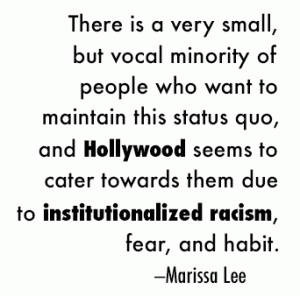
JL: How can consumers encourage more diversity in movies?
IS: Avoid buying tickets to films which clearly rely on stereotypes or demeaning portrayals of people based on gender, race, class, age, sexual orientation, ability, or circumstance. And anytime you do watch a film, give it The Representation Test afterward. The test grades films on their inclusiveness pertaining to all those above categories. When a movie scores really low on the test, use #NotBuyingIt on Twitter to let the filmmakers and all your friends know how you feel. Since so much of this industry is based on money, this is one way we can express our discontent and get the attention of the studios.
ML: Media literacy is a huge start. As media consumers, we should feel empowered to critique the media we consume, and to decide what media we choose to consume. Beyond helpful steps like going to see movies that feature diverse leads, it’s just as important to start conversations in our own communities and with our friends and family (the people we consume media with!) to raise awareness about diversity and representation. Even if we don’t go to see movies that whitewash or exclude or present discriminatory content, people we know will. One way we can help change things is by continuing to start conversations. We need to create an environment where it is safe to criticize popular franchises for lacking diversity. We also need to keep drowning out the malcontents who cannot even handle actors of diverse backgrounds in supporting roles. Social media has really knocked down barriers when it comes to communicating our opinions with Hollywood brass. It’s also given us several spaces where we can discuss the media we consume with our friends and family. In addition, the internet has really changed how we access and consume media. There are Kickstarters and indie channels and online comics and other outlets so we don’t have to be reliant on big production studios or publishers as our only sources of entertainment.
JL: How close or far do you think we are from getting these statistics to change?
IS: When you’re talking about representation that is this low, it’s hard to go anywhere but up. For instance, 0% for women of color in top sci-fi films means I’m being honest when I say things will certainly improve soon, but that’s not saying much. I think we are pretty far away from true equality, or a cinema that reflects and includes the broad diversity of human experiences in the real world.
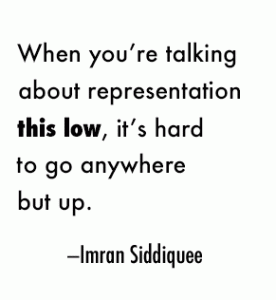 Too many wealthy, white men still run Hollywood, and their decisions still have too much power. As I mentioned earlier, these kinds of movies are very expensive, and so it’s hard for independent or upstart filmmakers to break through or compete.
Too many wealthy, white men still run Hollywood, and their decisions still have too much power. As I mentioned earlier, these kinds of movies are very expensive, and so it’s hard for independent or upstart filmmakers to break through or compete.
That being said, the slight increase in success for white women in blockbuster sci-fi movies, such as Gravity, The Hunger Games, and Divergent, means change is possible. And it’s hard to overstate the importance of the Oscar wins for 12 Years a Slave last year, because while it wasn’t a blockbuster, it is a film that everyone in the industry now knows about and has probably seen. And the whole reason we’re even talking about representation in movies right now is because we know how much seeing different experiences on screen can impact people’s real world thoughts and attitudes. So films like 12 Years a Slave are part of the gradual shifting of consciousness that has to happen in Hollywood to get to a point where studios are consistently greenlighting big-budget films starring people of color.
ML: As budgets for tentpole science fiction and fantasy movies have soared, studios have been more reluctant to take a chance on actors or characters that they perceive as risks. Because people of color and women are also already more likely to consume movies than white people and men, maybe they don’t feel an incentive to change what they are doing because, from their perspective, minorities are perfectly willing to watch films starring white guys. Hollywood is pretty stubborn, especially when it comes to tentpole movies. We are seeing more diversity in television, particularly in children’s television, as well as in online content. The establishment will change when someone influential in Hollywood decides to take the risk and make an effort to diversify their film offerings. The stats in this infographic are focused on profit, not art. For things to change, Hollywood needs to believe that diversity can be profitable.
***
This is not an isolated incident, but a wide reaching societal problem.
Read more Diversity Gap studies on:
The Academy Awards
The Tony Awards
The Emmy Awards
The children’s book industry
The New York Times Top 10 Bestseller List
US politics
Further resources on how to teach content and visual literacy using Lee & Low Books’ infographics series on the Diversity Gap:
Using Infographics In The Classroom To Teach Visual Literacy
CONTACT: For more information or to request permission to reprint, please email hehrlich[at]leeandlow[dot]com
Filed under:
Diversity, Race, and Representation,
Guest Blogger Post,
The Diversity Gap Tagged:
African/African American Interest,
Asian/Asian American,
diversity,
Latino/Hispanic/Mexican,
LGBT,
Middle Eastern,
Multiracial,
Native American,
Race issues,
Science Fiction/Fantasy,
whitewashing 

 The daughter of an anthropologist, Laura Reiko Simeon’s passion for diversity-related topics stems from her childhood spent living all over
The daughter of an anthropologist, Laura Reiko Simeon’s passion for diversity-related topics stems from her childhood spent living all over  the US and the world. She fell in love with Sweden thanks to the Swedish roommate she met in Wales while attending one of the United World Colleges, international high schools dedicated to promoting cross-cultural understanding. Laura has an MA in History from the University of British Columbia, and a Master of Library and Information Science from the University of Washington. She lives near Seattle.
the US and the world. She fell in love with Sweden thanks to the Swedish roommate she met in Wales while attending one of the United World Colleges, international high schools dedicated to promoting cross-cultural understanding. Laura has an MA in History from the University of British Columbia, and a Master of Library and Information Science from the University of Washington. She lives near Seattle.
As the Librarian and Diversity Coordinator at a school with a global population, my guiding vision is that the books I offer must be both mirrors that reflect children’s lives and windows that open up new worlds. This is a challenge when the small percentage of children’s books in English showing people of color is largely restricted to stories of oppression far removed from my students’ daily lives of homework, soccer, and wishing for a puppy. Of 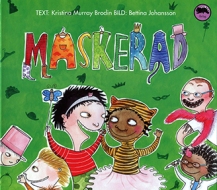 course it’s important to be aware of injustice, but it sends a powerful message if we only show racial diversity in settings of suffering and conflict.
course it’s important to be aware of injustice, but it sends a powerful message if we only show racial diversity in settings of suffering and conflict.
While “diversity” is not generally the first word that comes to mind when Americans think of Sweden, today fully 20% of Swedes are either immigrants or children of immigrants, many from Africa, Asia and the Middle East. Combine this with Swedes’ commitment to children’s rights and a vibrant literary and artistic community, and you have the perfect setting for stimulating debates and boundary-pushing creativity.
A grant from the Swedish Institute allowed me to visit Stockholm last year to interview librarians, authors, illustrators, publishers, and teachers about how recent picture books reflect their multicultural society. During my visit I learned about a fundamental distinction between their approach to diversity and our own. There is a concerted effort to publish works of artistic and literary merit, free from heavy moralizing, that express a child’s perspective and tear down the walls that segregate people of color into a few categories: civil rights hero, the downtrodden, and token exotic friend.
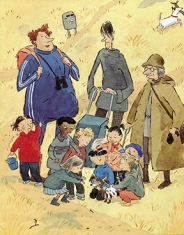
from Bridget and the Gray Wolves by Pija Lindenbaum
There is a firm belief in Sweden that the problem in stories must be about something other than differences.Marie Tomicic, of the Swedish multicultural publisher OLIKA, explained that when the problem in the story is the fact that a boy is playing with a doll, that sends a very different message from a book where the boy’s choice of a doll is unremarkable and the conflict “emerges from the play itself,” such as arguing about what scenario to act out.
This is why recent Swedish picture books that show ethnic diversity involve conflicts about ordinary, universal topics such as sharing. Several authors who are passionate about diversity proudly told me that if you were to read the text alone, you would never know that the illustrations in their books showed characters of many races. Often it’s even hard to tell exactly what ethnicity characters are meant to be. The Swedish Institute for Children’s Books monitors and publishes detailed data about gender – but not race – largely because of this ambiguity.
Gunna Grähs, a prolific author and illustrator, writes about a multicultural Swedish suburb where immigrants from several continents pursue ordinary daily activities such as buying lottery tickets or helping a neighbor who forgot to feed his cat. For decades Siv Widerberg has written stories in which multiethnic groups of children build sandcastles at daycare, collect sticks in the woods, and more. Anna Bengtsson shows characters with different ethnic backgrounds going to the hairdresser or playing in a pile of snow. Similarly, Eva Lindström, Lena Anderson, Eva Susso, Pija Lindenbaum, and many other Swedish writers are revolutionizing children’s literature simply by bringing people of color out of the margins and into the mainstream of daily life.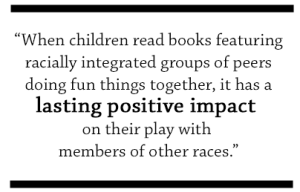
This is not to say that Swedes have arrived at a place of perfect enlightenment. Many of them admire our willingness to publish children’s books that explicitly talk about prejudice, since history and culture have made this topic uncomfortable in their own country.
Controversy erupted in Sweden 2012 over Little Heart, a character intended to reclaim and empower the pickaninny stereotype. There was also heated debate about whether hip hop artist and children’s culture advocate Behrang Miri was justified in moving Tintin in the Congo to the adult section of a library. In response to these painful incidents, Professor of Illustration Joanna Rubin Dranger has been working on improving Swedes’ visual literacy 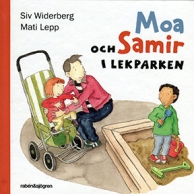 around racial stereotypes through her fascinating School of Images.
around racial stereotypes through her fascinating School of Images.
Yet recent research supports a significant benefit of the Swedish approach: when children read books featuring racially integrated groups of peers doing fun things together, it has a lasting positive impact on their play with members of other races. (This was not the case when they read diverse books showing members of just one race.) The bad news? There are so few of these types of books that likely “most American children have rarely or never seen a cross-race friendship depicted in a picture book.”
What can we do without access to most of these wonderful Swedish books? We can bring greater intentionality to how we choose diverse books. We can search for and purchase books that show diversity as a natural and positive aspect of daily life. We can discuss the implicit and explicit messages in diverse books with young readers, helping them learn to read with awareness. Children deserve more from their diverse books: let’s start tearing down those walls.
Filed under:
Diversity, Race, and Representation,
Guest Blogger Post Tagged:
cultural diversity,
diversity in publishing,
diversity issues,
sweden 

 Maya Christina Gonzalez is an award
Maya Christina Gonzalez is an award![]() -winning author and illustrator. In this post, cross-posted from her website, Maya shares why she decided to make her new picture book, Call Me Tree/ Llámame árbol, completely gender neutral.
-winning author and illustrator. In this post, cross-posted from her website, Maya shares why she decided to make her new picture book, Call Me Tree/ Llámame árbol, completely gender neutral.









 And then there’s the stark imprint of privilege found in the gaps and silences of
And then there’s the stark imprint of privilege found in the gaps and silences of 





 Frané Lessac has illustrated more than thirty-five books for young readers, several of which she has also written. Her husband, Mark Greenwood, is the author of numerous children’s books published in both the United States and his native Australia. They live in Fremantle, West Australia.
Frané Lessac has illustrated more than thirty-five books for young readers, several of which she has also written. Her husband, Mark Greenwood, is the author of numerous children’s books published in both the United States and his native Australia. They live in Fremantle, West Australia. Jersey Farm Scribe here on…
Jersey Farm Scribe here on… Paula Yoo is a children’s book writer, television writer, and freelance violinist living in
Paula Yoo is a children’s book writer, television writer, and freelance violinist living in
 Twenty-two Cents: Muhammad Yunus and the Village Bank is a biography of 2006 Nobel Peace Prize winner Muhammad Yunus, who founded Grameen Bank and revolutionized global antipoverty efforts by developing the innovative economic concept of micro-lending.
Twenty-two Cents: Muhammad Yunus and the Village Bank is a biography of 2006 Nobel Peace Prize winner Muhammad Yunus, who founded Grameen Bank and revolutionized global antipoverty efforts by developing the innovative economic concept of micro-lending.















 course it’s important to be aware of injustice, but it sends a powerful message if we only show racial diversity in settings of suffering and conflict.
course it’s important to be aware of injustice, but it sends a powerful message if we only show racial diversity in settings of suffering and conflict.

 around racial stereotypes through her fascinating
around racial stereotypes through her fascinating
You raise good points for further discussion. We value the context you give to discussions for diversity in children’s literature. Thank you, Tura Campanella Cook, Board President of the Jane Addams Peace Association. (We also honored “The Storyteller’s Candle” with the Jane Addams Children’s Book Award!)